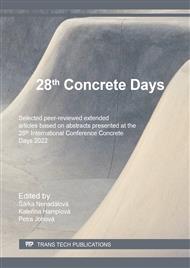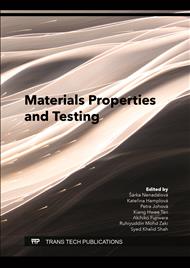p.135
p.145
p.151
p.159
p.165
p.173
p.179
p.185
p.193
The Effect of Granite Filler Grain Size on its Physical and Chemical Properties with Regard to Use in Cement Composites
Abstract:
The article deals with the use of granite filer as a concrete admixture. It examines the filter in detail not only as a whole (one component in concrete) but separates it into fractions. Since it is a filter produced during cutting, grinding and polishing of granite elements, it is granite slurry. For these reasons, the simplest method of separation - sedimentation in a flowing liquid - was applied to separate the individual fractions. After drying, the individual fractions were examined for their suitability for use in concrete. The most important physical and chemical parameters - bulk density, specific surface area, grain shape and size, chemical composition - were determined. Based on the measured values and in relation to previous in-house investigations, granite filer can be considered as a suitable admixture for cement composites.
Info:
Periodical:
Pages:
165-171
Citation:
Online since:
August 2022
Authors:
Keywords:
Price:
Сopyright:
© 2022 Trans Tech Publications Ltd. All Rights Reserved
Share:
Citation:



